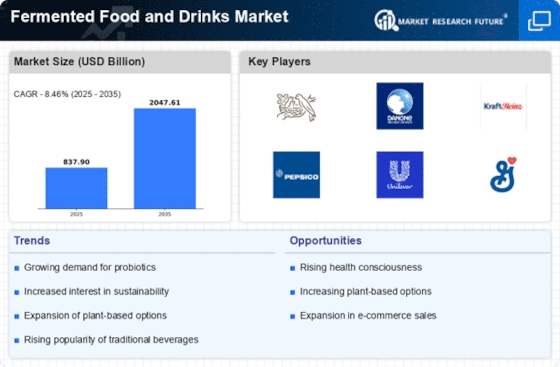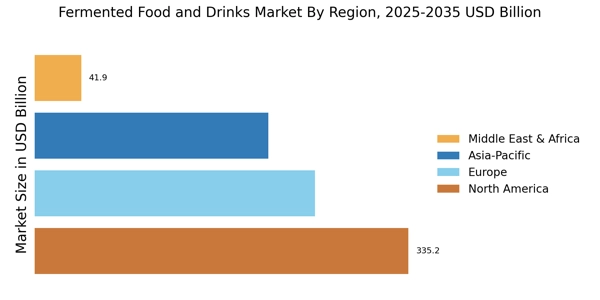Cultural and Culinary Trends
Cultural exploration and culinary diversity are increasingly influencing consumer preferences in the Fermented Food and Drinks Market. As globalization continues to shape food choices, traditional fermented products from various cultures, such as kimchi, miso, and sauerkraut, are gaining popularity. This trend is not merely about taste; it also encompasses a growing appreciation for the artisanal and authentic aspects of food preparation. The rise of food tourism and the desire for unique culinary experiences are driving consumers to seek out these products. Market data suggests that the demand for ethnic and specialty fermented foods is on the rise, as consumers are eager to experiment with flavors and cooking techniques from different cultures. This cultural curiosity is likely to sustain growth in the Fermented Food and Drinks Market.
Health Benefits of Fermented Foods
The increasing awareness of health benefits associated with fermented foods and drinks is a primary driver in the Fermented Food and Drinks Market. Products such as yogurt, kefir, and kombucha are recognized for their probiotic content, which supports gut health and boosts the immune system. Research indicates that the consumption of fermented foods can lead to improved digestion and enhanced nutrient absorption. As consumers become more health-conscious, the demand for these products is expected to rise. In fact, the market for probiotic foods is projected to grow significantly, reflecting a shift towards healthier dietary choices. This trend is likely to continue, as more individuals seek out functional foods that contribute to overall well-being, thereby propelling the Fermented Food and Drinks Market forward.
Rise of Plant-Based Fermented Products
The rise of plant-based diets is significantly impacting the Fermented Food and Drinks Market. As more consumers adopt vegetarian and vegan lifestyles, there is a growing demand for plant-based fermented products such as coconut yogurt, almond milk kefir, and tempeh. These alternatives not only cater to dietary restrictions but also align with the increasing interest in health and wellness. Market data suggests that the plant-based food sector is expanding rapidly, with fermented options becoming a key segment. This trend is likely to continue, as consumers seek nutritious and flavorful alternatives to traditional dairy and meat products. The innovation in plant-based fermentation techniques is expected to further enhance the variety and appeal of these products, driving growth in the Fermented Food and Drinks Market.
Convenience and Ready-to-Consume Options
The demand for convenience in food consumption is a significant driver in the Fermented Food and Drinks Market. As lifestyles become busier, consumers are increasingly seeking ready-to-eat and ready-to-drink options that fit their on-the-go lifestyles. Fermented foods such as pre-packaged kimchi, drinkable yogurts, and bottled kombucha are gaining traction due to their convenience and health benefits. Market analysis indicates that the convenience food sector is experiencing robust growth, with consumers willing to pay a premium for products that offer both health benefits and ease of use. This trend is likely to encourage manufacturers to innovate and expand their product lines, thereby enhancing the overall appeal of the Fermented Food and Drinks Market.
Sustainability and Environmental Concerns
Sustainability is becoming a crucial consideration for consumers, influencing their purchasing decisions in the Fermented Food and Drinks Market. As awareness of environmental issues grows, many consumers are gravitating towards products that are produced sustainably and with minimal environmental impact. Fermented foods often utilize local ingredients and traditional methods, which can reduce carbon footprints. Additionally, the fermentation process itself can enhance food preservation, thereby minimizing waste. Market trends indicate that brands emphasizing sustainable practices are likely to attract a more environmentally conscious consumer base. This shift towards sustainability is expected to drive innovation and growth within the Fermented Food and Drinks Market, as companies adapt to meet the evolving demands of their customers.


















Leave a Comment